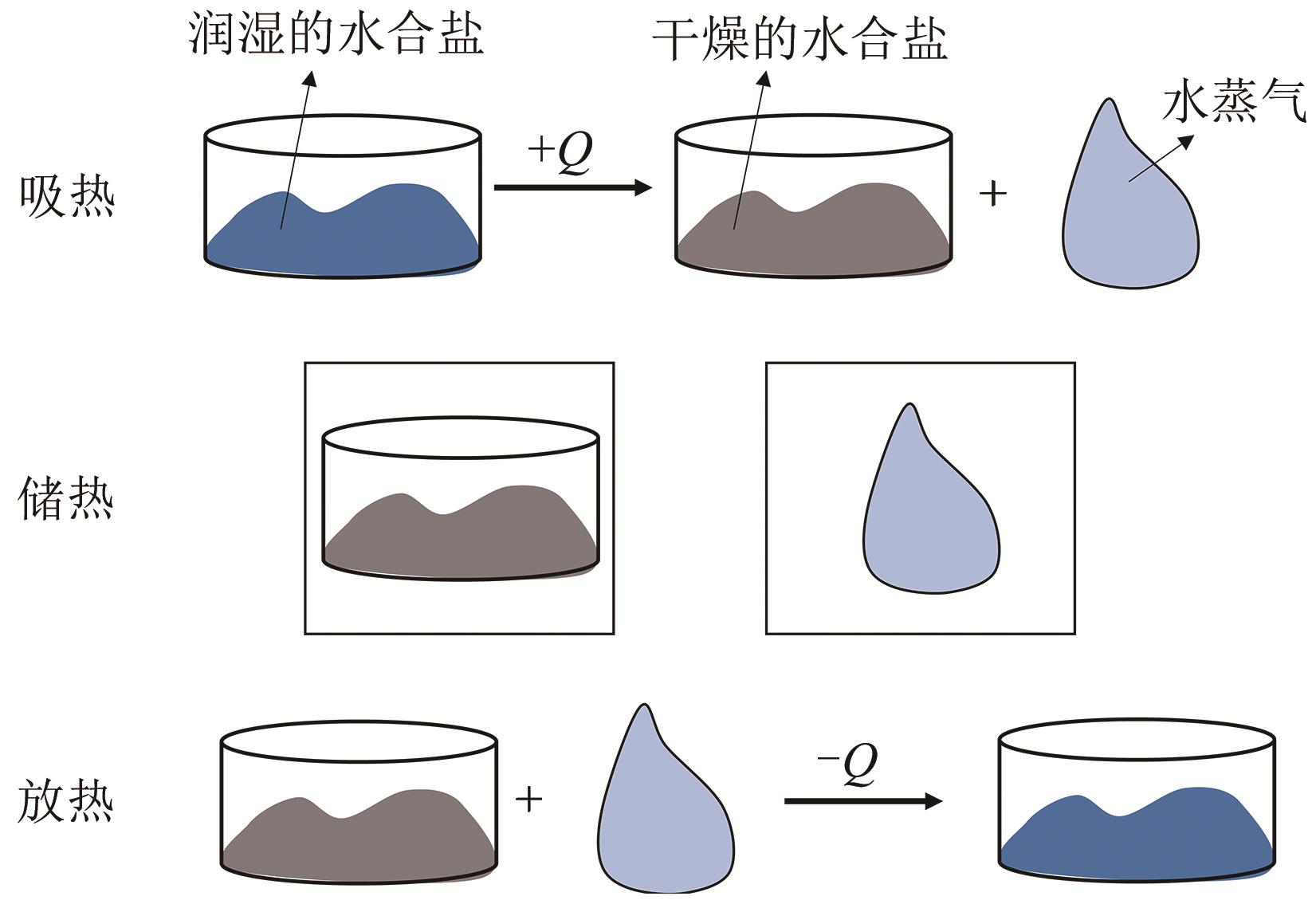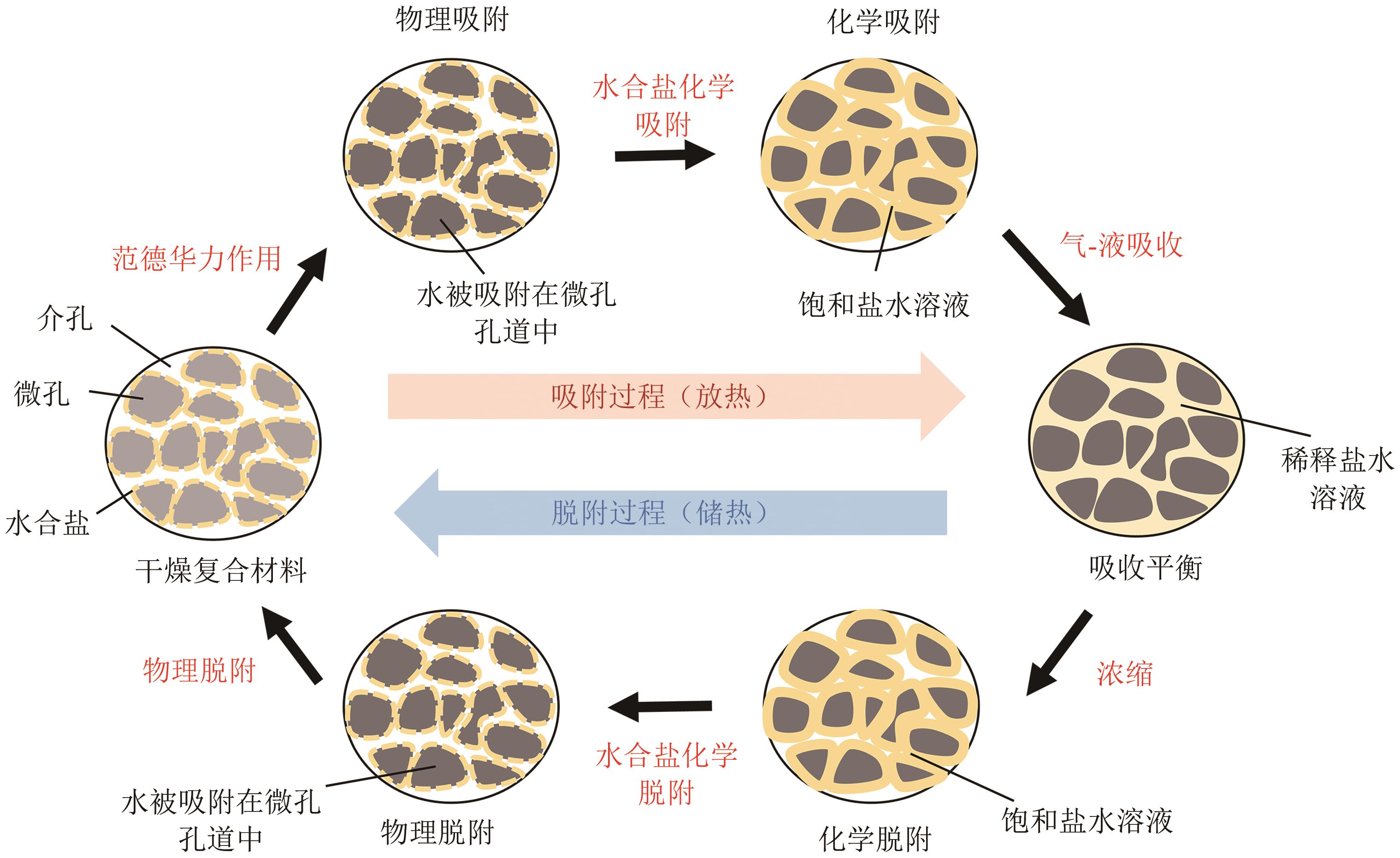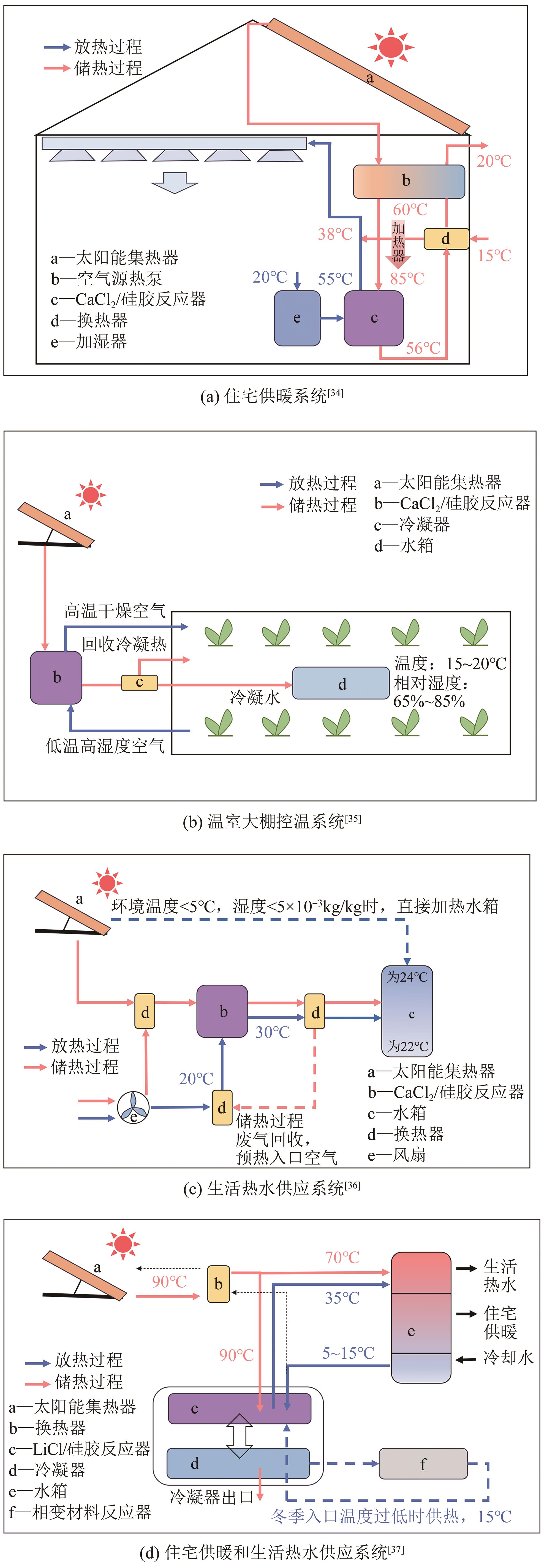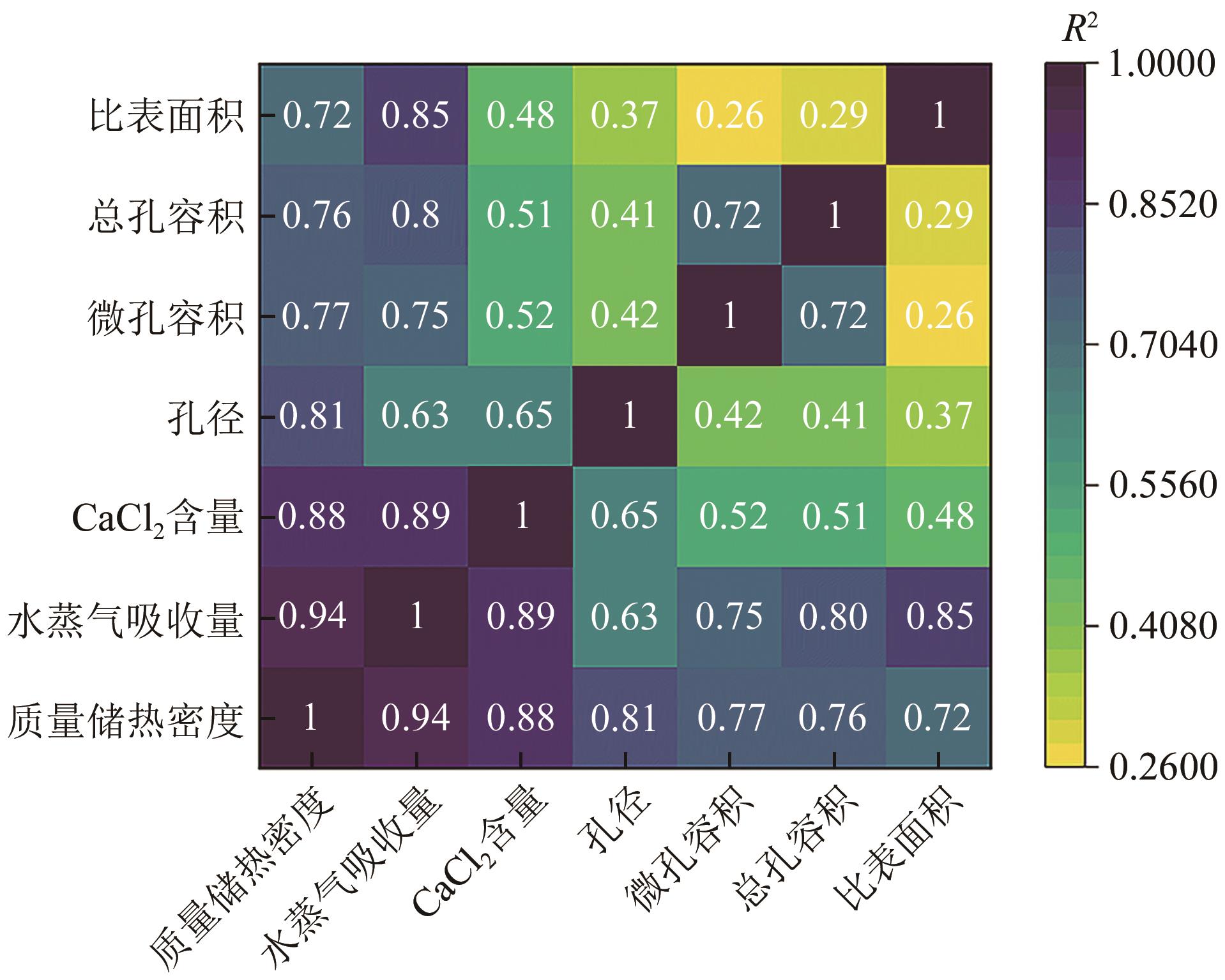化工进展 ›› 2024, Vol. 43 ›› Issue (8): 4506-4515.DOI: 10.16085/j.issn.1000-6613.2023-1244
• 材料科学与技术 • 上一篇
CaCl2复合热化学储热材料的研究进展
孙忻茹1( ), 张秋怡2, 卓建坤2(
), 张秋怡2, 卓建坤2( ), 杨润1, 姚强1,2
), 杨润1, 姚强1,2
- 1.新疆大学电气工程学院,新疆 乌鲁木齐 830046
2.清华大学热科学与动力工程教育部重点实验室,北京 100084
-
收稿日期:2023-07-19修回日期:2023-11-13出版日期:2024-08-15发布日期:2024-09-02 -
通讯作者:卓建坤 -
作者简介:孙忻茹(2000—),女,硕士研究生,研究方向为热化学储热。E-mail:sunxr797@163.com。 -
基金资助:教育部煤炭分级转化与清洁发电协同创新中心科技创新项目(2022ZFJH04)
Research progress of CaCl2 composite thermochemical heat storage materials
SUN Xinru1( ), ZHANG Qiuyi2, ZHUO Jiankun2(
), ZHANG Qiuyi2, ZHUO Jiankun2( ), YANG Run1, YAO Qiang1,2
), YANG Run1, YAO Qiang1,2
- 1.College of Electrical Engineering, Xinjiang University, Urumqi 830046, Xinjiang, China
2.Key Laboratory of Thermal Science and Power Engineering, Ministry of Education, Tsinghua University, Beijing 100084, China
-
Received:2023-07-19Revised:2023-11-13Online:2024-08-15Published:2024-09-02 -
Contact:ZHUO Jiankun
摘要:
水合盐热化学储热技术具有储热密度高、长期储存热损失小等优点,有望解决太阳能供给与能源需求间不平衡的问题。CaCl2具有快速水合反应动力学、高储热密度、低成本、原料广泛的优势。然而,纯水合盐存在膨胀结块、热导率低、稳定性差等问题。目前,研究者主要通过高热导率的多孔基质担载使水合盐均匀分散,实现稳定性的提升,并通过微纳米孔增加气体扩散通道,加快反应速率。本文分析了CaCl2复合热化学储热材料性能的主要影响因素,分别从储/放热机理分析、性能评价指标、复合材料物性的调控三方面展开。研究发现,多孔基质的孔隙特性、CaCl2的担载量是影响复合材料储热密度的主要影响因素,介孔结构的多孔基质更适宜作为水合盐热化学反应的载体。同时,加入镁基盐类形成二元盐复合材料是另一种有效的物性调控方法,其中,MgCl2能有效提高CaCl2的循环稳定性,在50次循环测试后仍保持良好性能。最后,指出了未来研究的重要技术方向,即开发以介孔结构为主的多孔基质,包括提高多孔基质的孔道开放度和稳定性、探索构建新的二元盐复合材料以及储热系统与储热材料的匹配等。
中图分类号:
引用本文
孙忻茹, 张秋怡, 卓建坤, 杨润, 姚强. CaCl2复合热化学储热材料的研究进展[J]. 化工进展, 2024, 43(8): 4506-4515.
SUN Xinru, ZHANG Qiuyi, ZHUO Jiankun, YANG Run, YAO Qiang. Research progress of CaCl2 composite thermochemical heat storage materials[J]. Chemical Industry and Engineering Progress, 2024, 43(8): 4506-4515.
| 水合盐 | 最高能量密度/GJ∙m-3 | 标准摩尔反应焓变/kJ∙mol-1 | 吸附温度/℃ | 脱附温度/℃ | 30℃时潮解相对湿度/% | 循环稳定性/次 | 成本/EUR∙kg-1 |
|---|---|---|---|---|---|---|---|
| CaCl2 | 2.58 | 277 | 32 | 180 | 29 | 20 | 0.1 |
| MgSO4 | 2.27 | 335.7 | 25 | 200 | 90 | 7 | 0.4 |
| MgCl2 | 2.48 | 255 | 61 | 130 | 33 | 30 | 0.18 |
| Na2S | 2.79 | 148 | 66 | 80 | — | 4 | 0.65 |
| SrBr2 | 2.49 | 337 | 48 | 80 | 60 | 10 | 24 |
表1 常见水合盐的热力学性能[4,11]
| 水合盐 | 最高能量密度/GJ∙m-3 | 标准摩尔反应焓变/kJ∙mol-1 | 吸附温度/℃ | 脱附温度/℃ | 30℃时潮解相对湿度/% | 循环稳定性/次 | 成本/EUR∙kg-1 |
|---|---|---|---|---|---|---|---|
| CaCl2 | 2.58 | 277 | 32 | 180 | 29 | 20 | 0.1 |
| MgSO4 | 2.27 | 335.7 | 25 | 200 | 90 | 7 | 0.4 |
| MgCl2 | 2.48 | 255 | 61 | 130 | 33 | 30 | 0.18 |
| Na2S | 2.79 | 148 | 66 | 80 | — | 4 | 0.65 |
| SrBr2 | 2.49 | 337 | 48 | 80 | 60 | 10 | 24 |
| 多孔基质 | 孔隙结构 | 复合材料 | 参考文献 | ||||||
|---|---|---|---|---|---|---|---|---|---|
| 孔径/nm | 微孔容积 /cm3·g-1 | 总孔容积 /cm3·g-1 | 比表面积 /m2·g-1 | 制备方法 | CaCl2质量分数 /% | 水蒸气吸收量 /g·g-1 | 质量储热密度 /kJ·kg-1 | ||
| 硅胶 | 12 | — | 1.06 | 320 | 等体积浸渍 | 43 | 0.77 | 1080 | [ |
| 2.45 | 0.381 | 1.31 | 785 | 等体积浸渍 | 24 | 0.6 | — | [ | |
| 氧化铝 | 4 | — | 0.25 | 214 | 等体积浸渍 | 14.4 | 0.17 | 576 | [ |
| 膨润土 | 6 | — | 0.34 | 225 | 等体积浸渍 | 15.22 | 0.23 | 719 | |
| 膨胀石墨 | 218.69 | — | 0.63 | 11.51 | 湿法浸渍 | 48.1 | 0.79 | 1637.6 | [ |
| 活性炭 | 1.98 | 0.395 | 2.365 | 678 | 等体积浸渍 | 24 | 0.49 | — | [ |
| — | — | — | — | 湿法浸渍 | 63 | 0.24 | 645 | [ | |
| 0.7~0.3 | — | 0.7~1.3 | 1432~1946 | 真空浸渍 | 31~58 | 0.12~0.2 | 235~298 | [ | |
| 蛭石 | — | — | 2.5 | — | 湿法浸渍 | 23.3~47.9 | 0.58~1.24 | 1764~4500 | [ |
| 沸石 | 42.8 | 0.153 | 1.489 | 233 | 等体积浸渍 | 24 | 0.6 | — | [ |
| PHTS① | 5.6~6.2 | 0.016~0.037 | 0.189~0.493 | 163~461 | 等体积浸渍 | — | 0.78~2.24 | — | [ |
| 膨胀珍珠岩 | 30.88 | — | 0.03 | 4 | 真空浸渍 | — | 1.22 | 1080 | [ |
| MWNT | 20 | — | — | 36~55 | 研磨混合 | 50 | 1.17~1.25 | — | [ |
| MOF | — | 0.47~1.05 | 1.01~2.49 | 1706~3279 | 真空浸渍 | 43.7~46 | 0.4~0.6 | 711~1274 | [ |
| 1.34 | — | 1.13 | 2397 | 湿法浸渍 | 52.8 | 0.98 | — | [ | |
| — | — | 0.5~1.95 | 1119~3721 | 湿法浸渍 | 40~62 | — | 874.8~1746 | [ | |
| SBA-15 | 8.2 | 0.81 | 1 | 828 | 湿法浸渍 | 76 | — | 1290.5~1704.5 | [ |
| 富马酸铝 | — | 0.07 | 0.54 | 959 | 湿法浸渍 | 25~58 | 0.37~0.68 | 998~1840 | [ |
| 富马酸铝/氧化铝 | — | 0.48 | 0.72 | 623 | 湿法浸渍 | 23~61 | 0.29~0.68 | 998~1938 | [ |
| 硅胶/氧化铝 | 4.7 | — | 0.8 | 628 | 等体积浸渍 | 5.3~24.4 | — | 503~886 | [ |
| 膨润土/石墨 | 5.35 | — | 0.062 | 42.19 | 等体积浸渍 | — | — | 854.5 | [ |
| 海藻酸钠 | — | — | — | — | 水凝胶法 | 80~90 | 0.88 | 1206 | [ |
表2 多孔基质孔隙结构和复合材料部分储热性能
| 多孔基质 | 孔隙结构 | 复合材料 | 参考文献 | ||||||
|---|---|---|---|---|---|---|---|---|---|
| 孔径/nm | 微孔容积 /cm3·g-1 | 总孔容积 /cm3·g-1 | 比表面积 /m2·g-1 | 制备方法 | CaCl2质量分数 /% | 水蒸气吸收量 /g·g-1 | 质量储热密度 /kJ·kg-1 | ||
| 硅胶 | 12 | — | 1.06 | 320 | 等体积浸渍 | 43 | 0.77 | 1080 | [ |
| 2.45 | 0.381 | 1.31 | 785 | 等体积浸渍 | 24 | 0.6 | — | [ | |
| 氧化铝 | 4 | — | 0.25 | 214 | 等体积浸渍 | 14.4 | 0.17 | 576 | [ |
| 膨润土 | 6 | — | 0.34 | 225 | 等体积浸渍 | 15.22 | 0.23 | 719 | |
| 膨胀石墨 | 218.69 | — | 0.63 | 11.51 | 湿法浸渍 | 48.1 | 0.79 | 1637.6 | [ |
| 活性炭 | 1.98 | 0.395 | 2.365 | 678 | 等体积浸渍 | 24 | 0.49 | — | [ |
| — | — | — | — | 湿法浸渍 | 63 | 0.24 | 645 | [ | |
| 0.7~0.3 | — | 0.7~1.3 | 1432~1946 | 真空浸渍 | 31~58 | 0.12~0.2 | 235~298 | [ | |
| 蛭石 | — | — | 2.5 | — | 湿法浸渍 | 23.3~47.9 | 0.58~1.24 | 1764~4500 | [ |
| 沸石 | 42.8 | 0.153 | 1.489 | 233 | 等体积浸渍 | 24 | 0.6 | — | [ |
| PHTS① | 5.6~6.2 | 0.016~0.037 | 0.189~0.493 | 163~461 | 等体积浸渍 | — | 0.78~2.24 | — | [ |
| 膨胀珍珠岩 | 30.88 | — | 0.03 | 4 | 真空浸渍 | — | 1.22 | 1080 | [ |
| MWNT | 20 | — | — | 36~55 | 研磨混合 | 50 | 1.17~1.25 | — | [ |
| MOF | — | 0.47~1.05 | 1.01~2.49 | 1706~3279 | 真空浸渍 | 43.7~46 | 0.4~0.6 | 711~1274 | [ |
| 1.34 | — | 1.13 | 2397 | 湿法浸渍 | 52.8 | 0.98 | — | [ | |
| — | — | 0.5~1.95 | 1119~3721 | 湿法浸渍 | 40~62 | — | 874.8~1746 | [ | |
| SBA-15 | 8.2 | 0.81 | 1 | 828 | 湿法浸渍 | 76 | — | 1290.5~1704.5 | [ |
| 富马酸铝 | — | 0.07 | 0.54 | 959 | 湿法浸渍 | 25~58 | 0.37~0.68 | 998~1840 | [ |
| 富马酸铝/氧化铝 | — | 0.48 | 0.72 | 623 | 湿法浸渍 | 23~61 | 0.29~0.68 | 998~1938 | [ |
| 硅胶/氧化铝 | 4.7 | — | 0.8 | 628 | 等体积浸渍 | 5.3~24.4 | — | 503~886 | [ |
| 膨润土/石墨 | 5.35 | — | 0.062 | 42.19 | 等体积浸渍 | — | — | 854.5 | [ |
| 海藻酸钠 | — | — | — | — | 水凝胶法 | 80~90 | 0.88 | 1206 | [ |
| 1 | LAURA Cozzi, Gül TIMUR. Net Zero by 2050: A Roadmap for the Global Energy Sector[R]. France: IEA, 2021. |
| 2 | 王亚蓉, 丁静, 陆建峰, 等. 太阳模拟器加热下甲烷重整管式反应器的热化学储能特性[J]. 太阳能学报, 2021, 42(11): 163-168. |
| WANG Yarong, DING Jing, LU Jianfeng, et al. Thermochemical energy storage characteristics of methane steam reforming in tube reactor with focused solar simulation[J]. Acta Energiae Solaris Sinica, 2021, 42(11): 163-168. | |
| 3 | 汪德良, 张纯, 杨玉, 等. 基于太阳能光热发电的热化学储能体系研究进展[J]. 热力发电, 2019, 48(7): 1-9. |
| WANG Deliang, ZHANG Chun, YANG Yu, et al. Research progress of thermochemical energy storage system based on solar thermal power generation[J]. Thermal Power Generation, 2019, 48(7): 1-9. | |
| 4 | 翁立奎, 张叶龙, 姜琳, 等. 基于水合盐的热化学吸附储热技术研究进展[J]. 储能科学与技术, 2020, 9(6): 1729-1736. |
| WENG Likui, ZHANG Yelong, JIANG Lin, et al. Research progress on thermochemical adsorption heat storage technology based on hydrate[J]. Energy Storage Science and Technology, 2020, 9(6): 1729-1736. | |
| 5 | YAN Ting, ZHANG Hong. A critical review of salt hydrates as thermochemical sorption heat storage materials: Thermophysical properties and reaction kinetics[J]. Solar Energy, 2022, 242: 157-183. |
| 6 | ZHAO Qian, LIN Jianquan, HUANG Haotian, et al. Optimization of thermochemical energy storage systems based on hydrated salts: A review[J]. Energy and Buildings, 2021, 244: 111035-111069. |
| 7 | ZHOU Hong, ZHANG Dong. Investigation on pH/temperature-manipulated hydrothermally reduced graphene oxide aerogel impregnated with MgCl2 hydrates for low-temperature thermochemical heat storage[J]. Solar Energy Materials and Solar Cells, 2022, 241: 111740-111751. |
| 8 | BARSK Aleksi, YAZDANI Maryam Roza, KANKKUNEN Ari, et al. Exceptionally high energy storage density for seasonal thermochemical energy storage by encapsulation of calcium chloride into hydrophobic nanosilica capsules[J]. Solar Energy Materials and Solar Cells, 2023, 251: 112154-112168. |
| 9 | MAZUR Natalia, SALVIATI Sergio, HUININK Henk, et al. Impact of polymeric stabilisers on the reaction kinetics of SrBr2 [J]. Solar Energy Materials and Solar Cells, 2022, 238: 111648-111660. |
| 10 | MIAO Qi, ZHANG Yelong, JIA Xu, et al. MgSO4-expanded graphite composites for mass and heat transfer enhancement of thermochemical energy storage[J]. Solar Energy, 2021, 220: 432-439. |
| 11 | 杨慧, 童莉葛, 尹少武, 等. 水合盐热化学储热材料的研究概述[J]. 材料导报, 2021, 35(17): 17150-17162. |
| YANG Hui, TONG Lige, YIN Shaowu, et al. A review on the salt hydrate thermochemical heat storage materials[J]. Materials Reports, 2021, 35(17): 17150-17162. | |
| 12 | N’TSOUKPOE Kokouvi Edem, RAMMELBERG Holger Urs, LELE Armand Fopah, et al. A review on the use of calcium chloride in applied thermal engineering[J]. Applied Thermal Engineering, 2015, 75: 513-531. |
| 13 | DONKERS P A J, PEL L, ADAN O C G. Experimental studies for the cyclability of salt hydrates for thermochemical heat storage[J]. Journal of Energy Storage, 2016, 5: 25-32. |
| 14 | YU N, WANG R Z, WANG L W. Sorption thermal storage for solar energy[J]. Progress in Energy and Combustion Science, 2013, 39(5): 489-514. |
| 15 | ZHANG Xueling, WANG Feifei, LEI Xudong, et al. Influential factors and optimization analysis of adsorption refrigeration system performance[J]. AIP Advances, 2020, 10(10): 105315-105327. |
| 16 | KEMP R, KEEGAN S E. Calcium Chloride[M]. Germany: Ullmann’s Encyclopedia of Industrial Chemistry, 2003: 511-517. |
| 17 | FUJIOKA Keiko, SUZUKI Hiroshi. Thermophysical properties and reaction rate of composite reactant of calcium chloride and expanded graphite[J]. Applied Thermal Engineering, 2013, 50(2): 1627-1632. |
| 18 | 魏思雨. 氯化钙复合吸附剂用于太阳光直驱热化学储热研究[D]. 哈尔滨: 哈尔滨工业大学, 2021. |
| WEI Siyu. Calcium chloride composite sorbent for solar-driven thermochemical heat storage[D]. Harbin: Harbin Institute of Technology, 2021. | |
| 19 | XU J X, LI T X, CHAO J W, et al. High energy-density multi-form thermochemical energy storage based on multi-step sorption processes[J]. Energy, 2019, 185: 1131-1142. |
| 20 | YU N, WANG R Z, LU Z S, et al. Evaluation of a three-phase sorption cycle for thermal energy storage[J]. Energy, 2014, 67: 468-478. |
| 21 | ROSATO A, SIBILIO S. Preliminary experimental characterization of a three-phase absorption heat pump[J]. International Journal of Refrigeration, 2013, 36(3): 717-729. |
| 22 | LU Zisheng, WANG Ruzhu, GORDEEVA Larisa. Novel multi-step sorption-reaction energy storage cycles for air conditioning and temperature upgrading[J]. Energy, 2017, 118: 464-472. |
| 23 | 罗伊默, 芮金金, 徐薇, 等. 热化学储热反应器内水合盐物性调控及传热传质优化研究进展[J]. 储能科学与技术, 2021, 10(4): 1273-1284. |
| LUO Yimo, RUI Jinjin, XU Wei, et al. Research progress on physical property control and heat and mass transfer optimization of hydrated salt in thermochemical heat storage reactor[J]. Energy Storage Science and Technology, 2021, 10(4): 1273-1284. | |
| 24 | KIMPTON Harriet, ZHANG Xunli, STULZ Eugen. Decarbonising heating and hot water using solar thermal collectors coupled with thermal storage: The scale of the challenge[J]. Energy Reports, 2020, 6: 25-34. |
| 25 | OUSALEH Hanane AIT, SAIR Said, MANSOURI Said, et al. Enhanced inorganic salts stability using bentonite clay for high-performance and low-cost thermochemical energy storage[J]. Journal of Energy Storage, 2022, 49: 104140-104156. |
| 26 | MOLENDA Margarethe, STENGLER Jana, LINDER Marc, et al. Reversible hydration behavior of CaCl2 at high H2O partial pressures for thermochemical energy storage[J]. Thermochimica Acta, 2013, 560: 76-81. |
| 27 | 张艳楠, 王如竹, 李廷贤. 蛭石/氯化钙复合吸附剂的吸附特性和储热性能[J]. 化工学报, 2018, 69(1): 363-370. |
| ZHANG Yannan, WANG Ruzhu, LI Tingxian. Sorption characteristics and thermal storage performance of expanded vermiculite/CaCl2 composite sorbent[J]. CIESC Journal, 2018, 69(1): 363-370. | |
| 28 | GAO Na, DENG Lisheng, LI Jun, et al. Multi-form heat storage performance of expanded graphite based CaCl2 composites for low-grade heat source[J]. Energy Reports, 2022, 8: 12117-12125. |
| 29 | SHI Weina, ZHU Yanqing, SHEN Cong, et al. Water sorption properties of functionalized MIL-101(Cr)-X (X=—NH2, —SO3H, H, —CH3, —F) based composites as thermochemical heat storage materials[J]. Microporous and Mesoporous Materials, 2019, 285: 129-136. |
| 30 | CASEY Sean P, ELVINS Jon, RIFFAT Saffa, et al. Salt impregnated desiccant matrices for ‘open’ thermochemical energy storage—Selection, synthesis and characterisation of candidate materials[J]. Energy and Buildings, 2014, 84: 412-425. |
| 31 | WEI Siyu, ZHOU Wei, HAN Rui, et al. Scalable production of EP/CaCl2@C multistage core–shell sorbent for solar-driven sorption heat storage application[J]. Energy & Fuels, 2021, 35(8): 6845-6857. |
| 32 | SALGADO-PIZARRO R, CALDERÓN A, SVOBODOVA-SEDLACKOVA A, et al. The relevance of thermochemical energy storage in the last two decades: The analysis of research evolution[J]. Journal of Energy Storage, 2022, 51: 104377-104389. |
| 33 | KUZNIK Frédéric, JOHANNES Kévyn, OBRECHT Christian. Chemisorption heat storage in buildings: State-of-the-art and outlook[J]. Energy and Buildings, 2015, 106: 183-191. |
| 34 | AYDIN Devrim, CASEY Sean P, CHEN Xiangjie, et al. Numerical and experimental analysis of a novel heat pump driven sorption storage heater[J]. Applied Energy, 2018, 211: 954-974. |
| 35 | WANG Chenxi, ZOU Hao, DU Shuai, et al. Water and heat recovery for greenhouses in cold climates using a solid sorption system[J]. Energy, 2023, 270: 126919-126930. |
| 36 | SKRYLNYK Oleksandr, COURBON Emilie, HEYMANS Nicolas, et al. Combined solar thermochemical solid/gas energy storage process for domestic thermal applications: Analysis of global performance[J]. Applied Sciences, 2019, 9(9): 1946-1966. |
| 37 | CRESPO Alicia, Cèsar FERNÁNDEZ, David VÉREZ, et al. Thermal performance assessment and control optimization of a solar-driven seasonal sorption storage system for residential application[J]. Energy, 2023, 263: 125382-125398. |
| 38 | KUZNIK Frédéric, JOHANNES Kevyn, OBRECHT Christian, et al. A review on recent developments in physisorption thermal energy storage for building applications[J]. Renewable and Sustainable Energy Reviews, 2018, 94: 576-586. |
| 39 | CLARK Ruby-Jean, MEHRABADI Abbas, FARID Mohammed. State of the art on salt hydrate thermochemical energy storage systems for use in building applications[J]. Journal of Energy Storage, 2020, 27: 101145-101163. |
| 40 | MOHAMED Zbair, SIMONA Bennici. Survey summary on salts hydrates and composites used in thermochemical sorption heat storage: A review[J]. Energies, 2021, 14(11): 3105-3138. |
| 41 | ZHANG Yannan, WANG Ruzhu. Sorption thermal energy storage: Concept, process, applications and perspectives[J]. Energy Storage Materials, 2020, 27: 352-369. |
| 42 | 顾清之. 镁-氢化镁热化学蓄热系统数值模拟和实验研究[D]. 上海: 上海交通大学, 2013. |
| GU Qingzhi. Numerical simulation and experimental study of magnesium-magnesium hydride themochemical heat storage system[D]. Shanghai: Shanghai Jiao Tong University, 2013. | |
| 43 | FOPAH LELE Armand, N’TSOUKPOE Kokouvi Edem, OSTERLAND Thomas, et al. Thermal conductivity measurement of thermochemical storage materials[J]. Applied Thermal Engineering, 2015, 89: 916-926. |
| 44 | DONKERS P A J, SÖGÜTOGLU L C, HUININK H P, et al. A review of salt hydrates for seasonal heat storage in domestic applications[J]. Applied Energy, 2017, 199: 45-68. |
| 45 | JI J G, WANG R Z, LI L X. New composite adsorbent for solar-driven fresh water production from the atmosphere[J]. Desalination, 2007, 212(1/2/3): 176-182. |
| 46 | ZHANG Haiquan, YUAN Yanping, YANG Fan, et al. Inorganic composite adsorbent CaCl2/MWNT for water vapor adsorption[J]. RSC Advances, 2015, 5(48): 38630-38639. |
| 47 | COURBON Emilie, Pierre D’ANS, PERMYAKOVA Anastasia, et al. Further improvement of the synthesis of silica gel and CaCl2 composites: Enhancement of energy storage density and stability over cycles for solar heat storage coupled with space heating applications[J]. Solar Energy, 2017, 157: 532-541. |
| 48 | Amira JABBARI-HICHRI, BENNICI Simona, AUROUX Aline. CaCl2-containing composites as thermochemical heat storage materials[J]. Solar Energy Materials and Solar Cells, 2017, 172: 177-185. |
| 49 | DRUSKE Mona-Maria, Armand FOPAH-LELE, KORHAMMER Kathrin, et al. Developed materials for thermal energy storage: Synthesis and characterization[J]. Energy Procedia, 2014, 61: 96-99. |
| 50 | KORHAMMER Kathrin, DRUSKE Mona-Maria, Armand FOPAH-LELE, et al. Sorption and thermal characterization of composite materials based on chlorides for thermal energy storage[J]. Applied Energy, 2016, 162: 1462-1472. |
| 51 | Alenka RISTIĆ, LOGAR Nataša Zabukovec. New composite water sorbents CaCl2-PHTS for low-temperature sorption heat storage: Determination of structural properties[J]. Nanomaterials, 2018, 9(1): 27-43. |
| 52 | TAN Bingqiong, LUO Yanshu, LIANG Xianghui, et al. Composite salt in MIL-101(Cr) with high water uptake and fast adsorption kinetics for adsorption heat pumps[J]. Microporous and Mesoporous Materials, 2019, 286: 141-148. |
| 53 | PERMYAKOVA Anastasia, WANG Sujing, COURBON Emilie, et al. Design of salt-metal organic framework composites for seasonal heat storage applications[J]. Journal of Materials Chemistry A, 2017, 5(25): 12889-12898. |
| 54 | SILVESTER Lishil, TOULOUMET Quentin, KAMARUDDIN Aiman, et al. Influence of silica functionalization on water sorption and thermochemical heat storage of mesoporous SBA-15/CaCl2 composites[J]. ACS Applied Energy Materials, 2021, 4(6): 5944-5956. |
| 55 | TOULOUMET Quentin, SILVESTER Lishil, BOIS Laurence, et al. Water sorption and heat storage in CaCl2 impregnated aluminium fumarate MOFs[J]. Solar Energy Materials and Solar Cells, 2021, 231: 111332-111345. |
| 56 | TOULOUMET Quentin, POSTOLE Georgeta, SILVESTER Lishil, et al. Hierarchical aluminum fumarate metal-organic framework-alumina host matrix: Design and application to CaCl2 composites for thermochemical heat storage[J]. Journal of Energy Storage, 2022, 50: 104702-104715. |
| 57 | Amira JABBARI-HICHRI, BENNICI Simona, AUROUX Aline. Enhancing the heat storage density of silica-alumina by addition of hygroscopic salts (CaCl2, Ba(OH)2, and LiNO3)[J]. Solar Energy Materials and Solar Cells, 2015, 140: 351-360. |
| 58 | KALLENBERGER Paul A, POSERN Konrad, LINNOW Kirsten, et al. Alginate-derived salt/polymer composites for thermochemical heat storage[J]. Advanced Sustainable Systems, 2018, 2(7): 1700160-1700168. |
| 59 | 展佳, 秦善, 高静. 无机水合盐中水的状态与相变潜热的关系[J]. 北京大学学报(自然科学版), 2018, 54(1): 80-86. |
| ZHAN Jia, QIN Shan, GAO Jing. Storage of water in inorganic salt hydrates and the implications to latent heat in phase changes[J]. Acta Scientiarum Naturalium Universitatis Pekinensis, 2018, 54(1): 80-86. | |
| 60 | 徐玲, 徐海燕, 吴通好, 等. 新型复合分子筛的合成和催化应用[J]. 催化学报, 2006, 27(12): 1149-1158. |
| XU Ling, XU Haiyan, WU Tonghao, et al. Synthesis and catalytic applications of novel composite molecular sieves[J]. Chinese Journal of Catalysis, 2006, 27(12): 1149-1158. | |
| 61 | MITRA Sourav, MUTTAKIN Mahbubul, Kyaw THU, et al. Study on the influence of adsorbent particle size and heat exchanger aspect ratio on dynamic adsorption characteristics[J]. Applied Thermal Engineering, 2018, 133: 764-773. |
| 62 | 王利丰. 多级孔材料的合成、表征及催化性能初探[D]. 长春: 吉林大学, 2007. |
| WANG Lifeng. Synthesis, characterization, and catalytic properties of hierarchical porous materials[D]. Changchun: Jilin University, 2007. | |
| 63 | 魏思雨, 周伟, 韩瑞, 等. 硅藻土/CaCl2制备及热化学吸附储热性能研究[J]. 工程热物理学报, 2022, 43(4): 883-888. |
| WEI Siyu, ZHOU Wei, HAN Rui, et al. Development of diatomite/CaCl2 for thermochemical sorption heat storage[J]. Journal of Engineering Thermophysics, 2022, 43(4): 883-888. | |
| 64 | VAN DONK Sander, BITTER Johannes H, VERBERCKMOES An, et al. Physicochemical characterization of porous materials: Spatially resolved accessibility of zeolite crystals[J]. Angewandte Chemie International Edition, 2005, 44(9): 1360-1363. |
| 65 | ZOU Ting, FU Wanwan, LIANG Xianghui, et al. Hydrophilic modification of expanded graphite to develop form-stable composite phase change material based on modified CaCl2·6H2O[J]. Energy, 2020, 190: 116473-116480. |
| 66 | RAMMELBERG Holger U, OSTERLAND Thomas, PRIEHS Boris, et al. Thermochemical heat storage materials—Performance of mixed salt hydrates[J]. Solar Energy, 2016, 136: 571-589. |
| 67 | JI Wenjie, ZHANG Heng, LIU Shuli, et al. An experimental study on the binary hydrated salt composite zeolite for improving thermochemical energy storage performance[J]. Renewable Energy, 2022, 194: 1163-1173. |
| 68 | ZHANG Xueling, WANG Feifei, ZHANG Qi, et al. Heat storage performance analysis of ZMS-Porous media/CaCl2/MgSO4 composite thermochemical heat storage materials[J]. Solar Energy Materials and Solar Cells, 2021, 230: 111246. |
| [1] | 杨光, 姜瑞婷, 张玥, 符子剑, 刘伟. 五氧化二钒/碳纳米复合材料在超级电容器中的应用[J]. 化工进展, 2024, 43(7): 3857-3871. |
| [2] | 赵伟刚, 张倩倩, 蓝钰玲, 闫雯, 周晓剑, 范毜仔, 杜官本. 真空绝热板芯材的研究进展与展望[J]. 化工进展, 2024, 43(7): 3910-3922. |
| [3] | 江慧珍, 罗凯, 王艳, 费华, 吴登科, 叶卓铖, 曹雄金. 废弃生物质复合相变材料的构建与应用[J]. 化工进展, 2024, 43(7): 3934-3945. |
| [4] | 杜倩, 侯明, 高冀芸, 杨黎, 鲁元佳, 郭胜惠. f-Ti3C2T x /ZIF-8异质结构增强NO2气体传感器的敏感性能[J]. 化工进展, 2024, 43(7): 3946-3954. |
| [5] | 张世蕊, 范朕连, 宋慧平, 张丽娜, 高宏宇, 程淑艳, 程芳琴. 粉煤灰负载光催化材料的研究进展[J]. 化工进展, 2024, 43(7): 4043-4058. |
| [6] | 刘梦凡, 王华伟, 王亚楠, 张艳茹, 蒋旭彤, 孙英杰. Bio-FeMnCeO x 活化PMS降解四环素效能与机制[J]. 化工进展, 2024, 43(6): 3492-3502. |
| [7] | 杨磊, 邱广薇, 李思言, 葛宏程, 孙园园, 王菲, 范晓光. 基于温度和葡萄糖双重响应性共聚物微囊的胰岛素控释载体[J]. 化工进展, 2024, 43(6): 3277-3284. |
| [8] | 刘涵, 曲明璐, 叶振东, 杨帆, 黄蓓佳, 张亚宁, 刘洪芝. 钙镁二元盐复合材料的储热性能[J]. 化工进展, 2024, 43(4): 1764-1773. |
| [9] | 刘雨蓉, 王兴宝, 李文英. 分子筛负载Pt催化剂酸性位点调控及对蒽深度加氢性能的影响[J]. 化工进展, 2024, 43(4): 1832-1839. |
| [10] | 熊文婷, 罗启基, 鄢春根. 二氧化硅基气凝胶材料及其制备技术的专利分析[J]. 化工进展, 2024, 43(4): 1912-1922. |
| [11] | 郭迎春, 梁晓怿. 柠檬酸改性球形活性炭对氨气吸附性能的影响[J]. 化工进展, 2024, 43(2): 1082-1088. |
| [12] | 见禹, 陈宝明, 宫晗语. 基于分级结构骨架相变储热系统强化传热特性[J]. 化工进展, 2024, 43(2): 649-658. |
| [13] | 代洪静, 马学虎, 王四芳. 低中放射性废水处理吸附技术及材料[J]. 化工进展, 2024, 43(1): 529-540. |
| [14] | 张明焱, 刘燕, 张雪婷, 刘亚科, 李从举, 张秀玲. 非贵金属双功能催化剂在锌空气电池研究进展[J]. 化工进展, 2023, 42(S1): 276-286. |
| [15] | 胡喜, 王明珊, 李恩智, 黄思鸣, 陈俊臣, 郭秉淑, 于博, 马志远, 李星. 二硫化钨复合材料制备与储钠性能研究进展[J]. 化工进展, 2023, 42(S1): 344-355. |
| 阅读次数 | ||||||
|
全文 |
|
|||||
|
摘要 |
|
|||||



